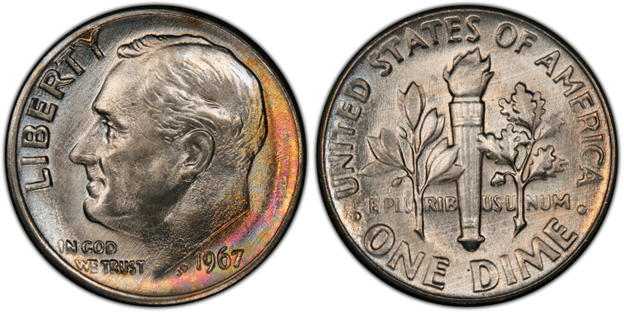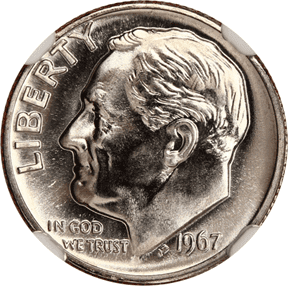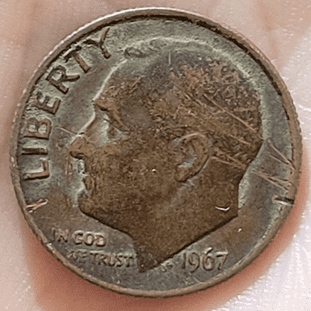What Makes A 1967 Roosevelt Dime Special?
The Roosevelt Dime, which has been in circulation since 1946, commemorates President Franklin D. Roosevelt’s support for the March of Dimes and his efforts to eradicate polio.
After being commissioned by Congress to develop a new dime in 1945, Chief Engraver John Sinnock created the design. In 1946, Sinnock’s design was introduced, replacing the preceding Winged Liberty Dime.
A right-facing bust of President Roosevelt is centered on the obverse. Along the right margin and right field, the mottos “LIBERTY” and “IN GOD WE TRUST” may be found. The bottom left of Roosevelt’s bust bears Sinnock’s initials and the date of mintage.
The principal design on the reverse of the coin includes a flame symbolizing liberty. There is a single set of olive branches, one on either side of the flame.
Between each of the branches and the flame is the ancient motto “E PLURIBUS UNUM.” Above and below the design are the words “UNITED STATES OF AMERICA” and “ONE DIME.”
Only the Philadelphia Mint was responsible for minting the Roosevelt Dime in 1967, hence none were produced in Denver or San Francisco.
The Mint in Philadelphia was forced to create all of the Roosevelt Dimes for that year, and they produced 2,244,007,000 of them. For the first time in mint history, only one branch produced more than two billion Roosevelt Dime coins.
The 1967 Roosevelt Dime is made up of 75 per cent copper and 25 per cent nickel after silver was withdrawn in 1964. This yielded a weight of 2.27 grammes and a diameter of 17.9 mm. On the coin’s edge, there is reeding.
In 1967 the ongoing Vietnam war dominated headlines. Also in 1967, NASA launches the Lunar Orbiter 3, Elvis Presley marries Priscilla Beaulieu in Las Vegas, and Walt Disney’s Carousel of Progress debuts at Disneyland.
In the United States, race riots expand to Washington, D.C. Businesswoman Muriel Siebert becomes the first woman to buy a seat on the New York Stock Exchange, and the Big Mac, the iconic hamburger, is created.
Is A 1967 Dime Made Of Silver?
Due to the increasing cost of the metal and the demand for silver-based coins from collectors, from 1965 onwards, all Dimes were made of 75% copper with 25% nickel cladding, which is what gives it its silver tone.
1967 Dime Varieties
1. 1967 Dime with No Mint Mark
Year: 1967
Face Value: $0.10
Composition: 75% Copper and 25% Nickel
Total Weight: 2.27g
Diameter: 17.91mm
Thickness: 1.35mm
Edge: 115 Reeds
Minted in: Philadelphia
Quantity Minted: 2,244,007,320

2. 1967 Special Mint Set Dime
Year: 1967
Face Value: $0.10
Composition: 75% Copper and 25% Nickel
Total Weight: 2.27g
Diameter: 17.91mm
Thickness: 1.35mm
Edge: 115 Reeds
Minted in: San Francisco
Quantity Minted: 1,863,344

3. Roosevelt Dime Errors
There are no widespread errors that are unique to the 1967 Roosevelt Dime. However, there are some common error examples seen across the dimes mintage years.

- Clipped Planchet—A missing part on clipped planchet dimes is caused by a misfeed during the minting process (often elliptical-shaped). On a good day, clipped planchet dimes in Mint State condition can pay $30!
- Blank Planchet—These one-of-a-kind dimes make their way out of the mint without ever being struck with a design. These dime errors, which are blank on both sides, usually have a value of only a few bucks.
- off-centre Strike—An off-center strike coin has an obverse or reverse image that was not properly aligned during the striking process. These coins are frequently deformed and have blank planchet sections. The value of the coin varies depending on the degree of the off-center striking, however, it can range from $10 to $20 per coin.
- Broadstrike— A smooth rim is always present on dimes with a broad strike fault. When the collar die fails during striking, this error occurs. The images on the obverse and reverse of the coin will frequently “extend” or stretch out, resulting in a somewhat deformed coin. The range of values for this dime inaccuracy was $5 to $10.
- Clad Layer Is Missing— A few dime planchets will be created with a missing Nickel Clad coating (as seen in the above image) due to an error in the minting process. On either the obverse or reverse side of the coin, the copper core is visible. The highest value for these coins is usually approximately $20.
What Is The Value Of 1967 Dime?
Due to the removal of any silver content, the 1967 Dime only has a melt value of $0.024, meaning that its face value is worth 5 times more than its melt value. This means that the only real value that 1967 Dimes have is their collectable value and not its intrinsic metal value.
Listed below are the expected values for a regular strike 1967 dime of varying grades.
- Grade MS61 = $2-$3
- Grade MS62 = $2-$4
- Grade MS63 = $3-$5
- Grade MS64 = $4-$6
- Grade MS65 = $8-$13
- Grade MS66 = $11-$19
- Grade MS67 = $15-$25
- Grade MS68 = $49-$81
- Grade PR63 = $5-$9
- Grade PR64 = $6-$10
- Grade PR65 = $8-$13
- Grade PR66 = $9-$15
- Grade PR67 = $15-$25
- Grade PR68 = $26-$44
How Does The Grading System Work?
The Sheldon Scale is used by numismatists to provide a numerical value to coins. The Sheldon Scale goes from poor (P-1) to perfect mint state (P-1) (MS-70). Coins were originally evaluated using words to reflect their condition (Good, Fair, Excellent, Etc.). Unfortunately, coin collectors and dealers had different ideas about what each of these terms represent.
Professional numismatists joined together in the 1970s and established CoinGrading standards. These numismatists now assign grades at key places on the seventy-point scale, using the most regularly utilized numeric points in conjunction with the original adjective grade. The following are the most common coin grades:
-
-
- (P-1) Poor – Indistinguishable and probably damaged; if used, must have a date and mintmark; otherwise, rather battered.
- (FR-2) Fair – Nearly smooth, but without the damage that a coin graded Poor often possesses. The coin must have enough detail to be identified.
- (G-4) Fair – Inscriptions have merged into the rims in some areas, and important elements have been mostly erased.
- (VG-8) Very Good- A little weathered, but all of the primary design elements are visible, albeit faintly. There is little if any, central detail left.
- (F-12) Good – The item is very worn, yet the wear is even, and the overall design details stand out clearly. Rims are almost completely isolated from the field.
- (VF-20) Very Fine – Moderately weathered, with some finer features still visible. The motto or all letters of LIBERTY are readable. Both sides of the coin have entire rims that are separated from the field.
- (EF-40) Extremely Fine – Gently used; all gadgets are visible, and the most important ones are bold. The finer details are bold and clear, however, light wear may be seen.
- (AU-50) Uncirculated – Slight evidence of wear on the coin’s design’s high points; may have contact marks; eye appeal should be adequate.
- (AU-58) Uncirculated Choice – Slight traces of wear, no severe contact marks, almost full mint shine, and great eye appeal.
- (MS-60) Mint State Basal – Strictly uncirculated; no indication of wear on the coin’s highest points, but an unsightly coin with reduced luster, visible contact marks, hairlines, and other flaws.
- (MS-63) Mint State Acceptable – Uncirculated, but with contact scratches and nicks, little reduced shine, but otherwise appealing appearance. The strike is weak to average.
- (MS-65) Mint State Choice – Uncirculated with great mint shine, very little contact blemishes, and exceptional eye appeal. The strike is unusually severe.
- (MS-68) Mint State Premium Quality – Uncirculated with superb luster, no obvious contact marks to the naked eye, and exceptional eye appeal. The strike is quick and appealing.
- (MS-69) Almost Perfect Mint State – Uncirculated with perfect brilliance, a sharp and appealing strike, and extremely good eye appeal. A near-perfect coin with minor imperfections in the planchet, strike, and contact markings (seen only under 8x magnification).
- (MS-70) Mint State Perfect – Under 8x magnification, there are no tiny imperfections discernible; the strike is crisp, and the coin is perfectly centered on a beautiful planchet. Rarely seen on a coin, this coin is bright and whole, with original luster and exceptional eye appeal.
-
Where To Buy Or Sell 1964 Dimes?
Most 1964 Dimes are sought after by newbie collectors and those who appreciate the nostalgic aspect of the mintage year because of its commonality and lack of intrinsic metal value.
As a result, internet marketplaces like eBay and Etsy are ideal for purchasing and selling 1967 dimes.
Specialist sites like Vcoins sell and buy more valuable Roosevelt dimes, such as error specimens or those of high-quality mintage.
FAQs
What is the value of a 1967 Canadian dime?
1967 Canadian Dimes feature a Fish in their design. As they contain a small amount of silver, Canadian Dimes are worth more than American dimes and can be worth between $0.73 and $2.70.
Did the 1967 dime have a mint mark?
There were no mint marks on all US coins from 1967 due to the congresses decision to remove all mint marks from coins starting in 1965 to hopefully reduce the booming hobby of coin collecting.
Where is the mint mark on a 1967 dime?
There is no mint mark on 1967 dimes, and all examples of this coin were minted in Philadelphia for the first time in history.
